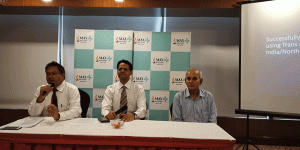TAVR Success – When Disease & Surgery both became deadly for heart patient
Published on July 27, 2019
Gurugram :3 months ago, when 68-year-old patient was told by the doctors that he needed a valve replacement, the only question was how can it be done.
The case was presented in a press conference on New technology use in treatment of Valvular Heart Disease. Present in the conference were Dr Arvind Das – Senior Director & HOD, Cardiology, Max  Hospital, Gurugram and Dr Niraj Kumar- Associate Director, Cardiology, Max Hospital Gurugram.
Hospital, Gurugram and Dr Niraj Kumar- Associate Director, Cardiology, Max Hospital Gurugram.
Dr Arvind Das tells that “The patient was diagnosed with valvular heart disease in the year 2007 and underwent open heart surgery to have his aortic valve replaced. In the year 2015 he was diagnosed with malfunctioning of another valve in the heart, called mitral valve & had it replaced, with the help of open-heart surgery again.”
He told “In the year 2019, doctors diagnosed that the aortic valve implanted in 2007 had worn out and needed immediate replacement again. But looking into the age and history of 2 (two) open heart surgeries in past, doctors found performing another surgery to be extremely risky and kept away from doing it.”
He said “As a result of having left untreated, the patient got admitted to ICU 3 times, 20 days each to control severe infections that developed because of the disease.”
“The patient was now a unique medical case where there was death risk, if left untreated and even if treated with surgery.” Doctor told
Dr Arvind Das tells that “When we analysed the case, we were of the opinion that the patient will not survive if valve is not replaced immediately. We could attempt open heart surgery but it would be very risky.”
“We then brought to the table use of new technology called Trans aortic Valve Replacement or TAVR. Using TAVR we insert a new valve through a small hole in the groin area, ride it to the heart. The new valve pushes old valve to sides and takes charge as new heart valve regulating blood flow.” He said
“It looked perfect for the patient. It was challenging, as case of replacement of replaced aortic valve through TAVR has not been performed earlier elsewhere. But we had no other option and hence went on with it.” He told
Dr Arvind says that the results have been fantastic. It was a successful application of procedure & we could easily replace the valve. Patient all vital status was normal, got discharged after 3 days and is back to routine activities. We are sure patient would not have seen this back to routine even after his first surgery.
Dr Niraj Kumar tells that “The procedure marks the beginning of a new paradigm in treating elderly people with valve disease, who otherwise carry a very high risk for open heart surgery.
He said “The only reason why still open-heart surgeries are performed for Valve Replacement is cost. But now, with strong presence of Indian Companies coming in competition with MNC players, this procedure cost has come down to half which is a big advantage for ailing patients.
He says “The Make in India initiative by Honorable Prime Minister Sh Narender Modi has facilitated indigenous manufacturing of TAVR, which makes it available to ailing patients at half the cost. The TAVR made in India is proves to be better because of its Zero Pacemaker Rate. It is now available in more than 100 countries; branding India is front runner in production of quality healthcare products.
Dr Niraj Kumar says that “Aortic Stenosis third most common cardiovascular disease, which is foreseen to grow as proportion of elderly population is expected to rise.
He tells that “According to reports the proportion of 60 plus population is expected to increase to about 22 percent from it current figure of 11.5%. The population elderly in India has increased from 77 million in 2001 to 104 million in 2011. In 2050 the number is expected to touch close to 300 million elderly people.”
He told that “The data points at the need of expanding healthcare facilities for elderly in India, with policy interventions that can facilitate early diagnosis & timely treatment.”











